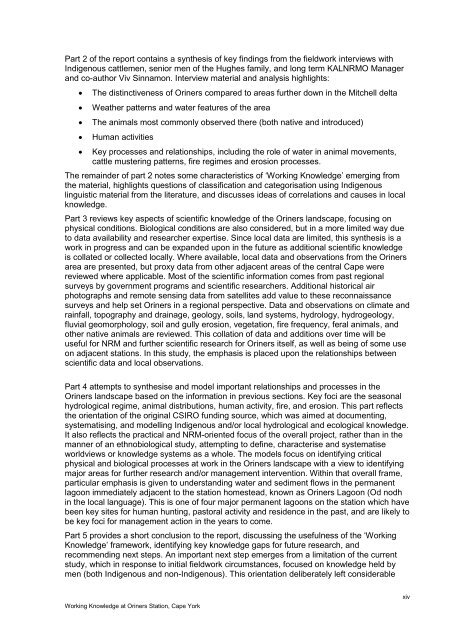WfHC - cover page (not to be used with pre-printed report ... - CSIRO
WfHC - cover page (not to be used with pre-printed report ... - CSIRO
WfHC - cover page (not to be used with pre-printed report ... - CSIRO
You also want an ePaper? Increase the reach of your titles
YUMPU automatically turns print PDFs into web optimized ePapers that Google loves.
Part 2 of the <strong>report</strong> contains a synthesis of key findings from the fieldwork interviews <strong>with</strong><br />
Indigenous cattlemen, senior men of the Hughes family, and long term KALNRMO Manager<br />
and co-author Viv Sinnamon. Interview material and analysis highlights:<br />
The distinctiveness of Oriners compared <strong>to</strong> areas further down in the Mitchell delta<br />
Weather patterns and water features of the area<br />
The animals most commonly observed there (both native and introduced)<br />
Human activities<br />
Key processes and relationships, including the role of water in animal movements,<br />
cattle mustering patterns, fire regimes and erosion processes.<br />
The remainder of part 2 <strong>not</strong>es some characteristics of „Working Knowledge‟ emerging from<br />
the material, highlights questions of classification and categorisation using Indigenous<br />
linguistic material from the literature, and discusses ideas of correlations and causes in local<br />
knowledge.<br />
Part 3 reviews key aspects of scientific knowledge of the Oriners landscape, focusing on<br />
physical conditions. Biological conditions are also considered, but in a more limited way due<br />
<strong>to</strong> data availability and researcher expertise. Since local data are limited, this synthesis is a<br />
work in progress and can <strong>be</strong> expanded upon in the future as additional scientific knowledge<br />
is collated or collected locally. Where available, local data and observations from the Oriners<br />
area are <strong>pre</strong>sented, but proxy data from other adjacent areas of the central Cape were<br />
reviewed where applicable. Most of the scientific information comes from past regional<br />
surveys by government programs and scientific researchers. Additional his<strong>to</strong>rical air<br />
pho<strong>to</strong>graphs and remote sensing data from satellites add value <strong>to</strong> these reconnaissance<br />
surveys and help set Oriners in a regional perspective. Data and observations on climate and<br />
rainfall, <strong>to</strong>pography and drainage, geology, soils, land systems, hydrology, hydrogeology,<br />
fluvial geomorphology, soil and gully erosion, vegetation, fire frequency, feral animals, and<br />
other native animals are reviewed. This collation of data and additions over time will <strong>be</strong><br />
useful for NRM and further scientific research for Oriners itself, as well as <strong>be</strong>ing of some use<br />
on adjacent stations. In this study, the emphasis is placed upon the relationships <strong>be</strong>tween<br />
scientific data and local observations.<br />
Part 4 attempts <strong>to</strong> synthesise and model important relationships and processes in the<br />
Oriners landscape based on the information in <strong>pre</strong>vious sections. Key foci are the seasonal<br />
hydrological regime, animal distributions, human activity, fire, and erosion. This part reflects<br />
the orientation of the original <strong>CSIRO</strong> funding source, which was aimed at documenting,<br />
systematising, and modelling Indigenous and/or local hydrological and ecological knowledge.<br />
It also reflects the practical and NRM-oriented focus of the overall project, rather than in the<br />
manner of an ethnobiological study, attempting <strong>to</strong> define, characterise and systematise<br />
worldviews or knowledge systems as a whole. The models focus on identifying critical<br />
physical and biological processes at work in the Oriners landscape <strong>with</strong> a view <strong>to</strong> identifying<br />
major areas for further research and/or management intervention. Within that overall frame,<br />
particular emphasis is given <strong>to</strong> understanding water and sediment flows in the permanent<br />
lagoon immediately adjacent <strong>to</strong> the station homestead, known as Oriners Lagoon (Od nodh<br />
in the local language). This is one of four major permanent lagoons on the station which have<br />
<strong>be</strong>en key sites for human hunting, pas<strong>to</strong>ral activity and residence in the past, and are likely <strong>to</strong><br />
<strong>be</strong> key foci for management action in the years <strong>to</strong> come.<br />
Part 5 provides a short conclusion <strong>to</strong> the <strong>report</strong>, discussing the usefulness of the „Working<br />
Knowledge‟ framework, identifying key knowledge gaps for future research, and<br />
recommending next steps. An important next step emerges from a limitation of the current<br />
study, which in response <strong>to</strong> initial fieldwork circumstances, foc<strong>used</strong> on knowledge held by<br />
men (both Indigenous and non-Indigenous). This orientation deli<strong>be</strong>rately left considerable<br />
Working Knowledge at Oriners Station, Cape York<br />
xiv
















